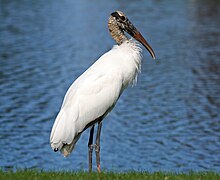Sometimes what scientists
need to protect a threatened species is a chainsaw, some roofing material and a
little bit of creativity. On the Georgia
It’s a bird that hasn’t
always nested in Georgia
Wood storks aren’t exactly
conventionally beautiful.
 “They’ve got virtually no
feathers on their neck or head, except when they’re very young,” says Tim
Keyes, a biologist with the DNR. “They’ve got long sort of drooping bills. And
as adults, they have kind of a black scaly look to their head and neck."
“They’ve got virtually no
feathers on their neck or head, except when they’re very young,” says Tim
Keyes, a biologist with the DNR. “They’ve got long sort of drooping bills. And
as adults, they have kind of a black scaly look to their head and neck."
Their feathers are mostly
white. Their bodies are sort of football shaped, and they’re tall – over three
feet.
“In flight, from a
distance, they’re actually quite attractive. The closer you get, the less
attractive they appear,” says Keyes, laughing.
Keyes and a group from the
DNR recently went to Sapelo
Island Sapelo Island
No comments:
Post a Comment